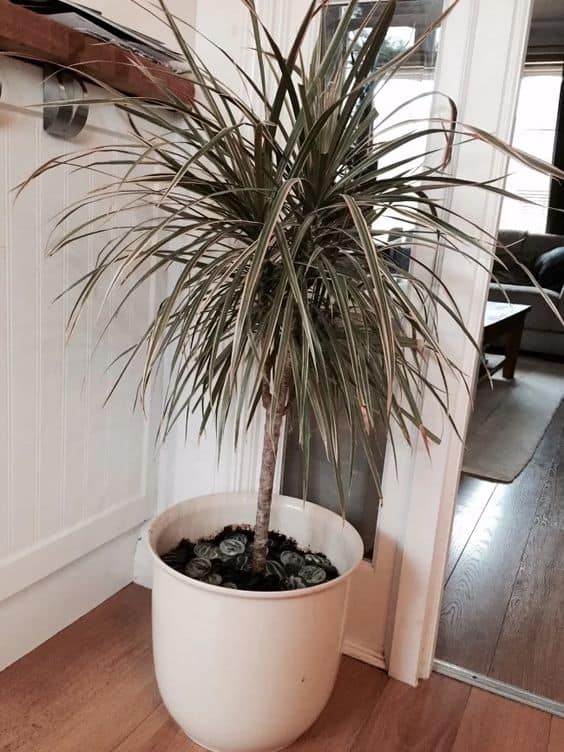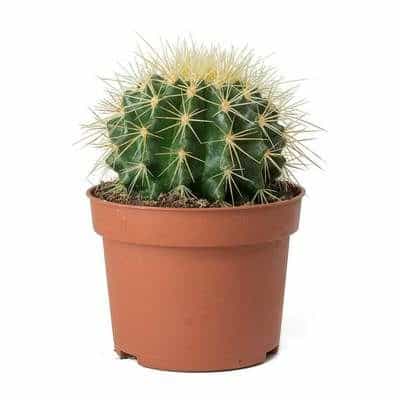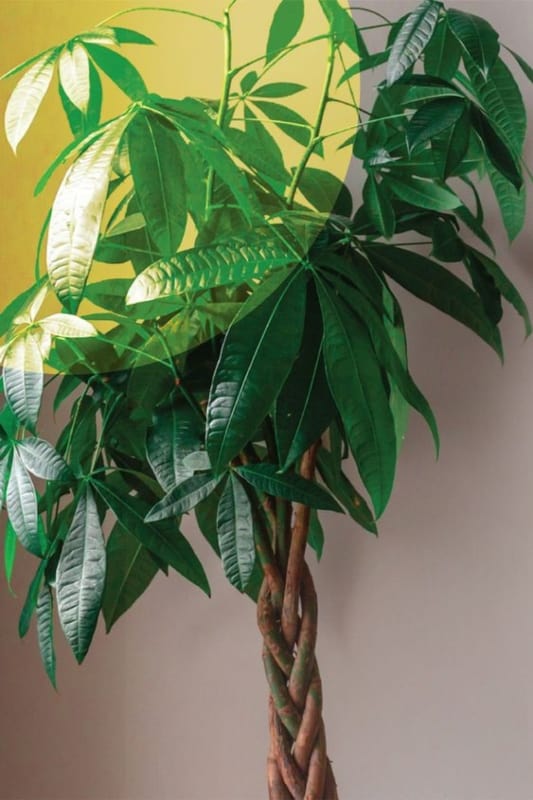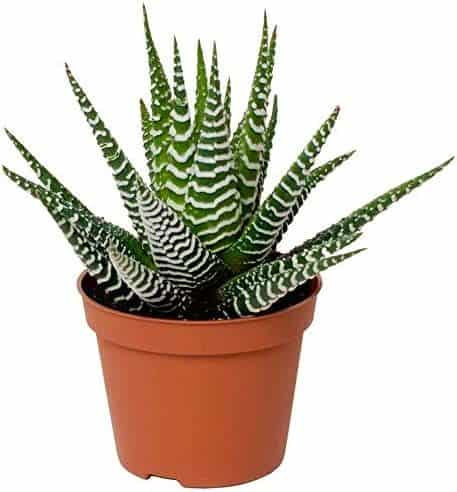If you’re looking for a way to bring a bit of the outdoors charm into your home, why not consider adding some plants that like direct sunlight?
They add a touch of nature to any room and provide numerous benefits, such as improving air quality and providing a sense of calm.
Plus, they’re surprisingly hardy and require minimal maintenance. From succulents to palms, there are plenty of options to choose from.
With the right selection, you can create a vibrant and healthy oasis that will add life to your home. So let’s dive in and discover some of the bright and beautiful plants that love direct sunlight!
1. Mother In Law’s Tongue

Botanical name: Sansevieria trifasciata
Soil PH: Neutral to slightly alkaline
Mother-in-law’s tongue, also known as Snake Plant, is a popular indoor plant known for its strong, tall sneaky-like leaves and ability to thrive in a wide range of lighting conditions. It is native to West Africa and can tolerate long periods of drought.
This plant is perfect for sunny spots and easy to care for, making it a great choice for beginners or busy plant owners, as it requires watering only once or twice a month.
2. Hibiscus

Botanical name: Hibiscus rosa-Sinensis
Soil PH: Neutral to slightly acidic
Hibiscus is a tropical plant known for its large, bright, colorful flowers. It is popular for gardens and patios and thrives in sunny, warm locations. Hibiscus is a fast-growing plant that requires regular watering and fertilizing to keep it healthy.
In addition to its beautiful flowers, Hibiscus is also known for its medicinal properties. The plant can treat various ailments, including colds, fluid retention, and stomach irritation.
3. Croton

Botanical name: Codiaeum variegatum
Soil PH: Neutral to slightly acidic
Bush of fire is another name for this plant known for its bright, colorful foliage. It is native to Southeast Asia and is popular for adding a pop of color to gardens and patios.
It requires plenty of sunshine to thrive and should be protected from frost. You need to expose the Croton to at least 6 hours of direct sunlight for healthy growth.
Its leaves will change from green to shades of red, orange, and yellow as it gets more sunlight. Which makes it a dynamic and interesting plant to add to any garden.
4. Aloe Vera

Botanical name: Aloe barbadensis miller
Soil PH: Slightly acidic to neutral
With the growing popularity of skincare products, the Aloe Vera plant is a great choice for your home’s indoor garden.
It’s also incredibly useful; the plant’s leaves have healing properties and can be used to soothe burns and irritation.
Aloe Vera is also one of the easiest indoor plants to propagate, so if you want to increase your collection, it’s simple.
5. Papyrus

Botanical name: Cyperus papyrus
Soil PH: Slightly acidic to neutral
The papyrus is one of the most interesting plants out there and is best suited for people with a bit more experience.
It can grow up to 3-6 feet tall and requires a fair amount of care and attention. It’s best to keep it in a pot so that you can move it around and water it easily.
6. Jade Plant

Botanical name: Crassula ovata
Soil PH: Slightly acidic to neutral
The jade plant is another excellent choice for beginners or people who don’t have enough time to maintain their indoor garden.
It’s also incredibly beautiful and has variegated leaves that are sure to add a pop of color to any room.
However, keep it away from children as it is mildly poisonous to humans upon digestion.
7. Sago Palm

Botanical name: Cycas revoluta
Soil PH: Slightly acidic to neutral
The sago palm is a good choice if you’re looking for a tall, tropical plant that thrives in direct sunlight.
It’s easy to grow and is known for growing quickly, making it a great choice for people who want a taller plant.
Remember that sago palms often grow quite large, so choose a pot that will accommodate them as they grow.
8. Areca Palm

Botanical name: Dypsis lutescens
Soil PH: Slightly acidic to neutral
The Areca palm is a decorative plant that can grow up to 8 feet tall and a few feet wide. It is also known as the “golden cane” because it can tolerate some yellowing under sunlight. It will add a tropical vibe to any room.
To help the areca palm thrive, place it next to a window facing south or west, and provide it with consistent moisture and high humidity.
9. Ponytail Palm

Botanical name: Beaucarnea recurvata
Soil PH: Slightly acidic to neutral
The ponytail palm is native to Mexico and is known for its bulb-like base and frizzy foliage. It thrives in direct sunlight but can also grow in indirect light, although it may not reach its full potential in height and growth rate.
The ponytail palm is a striking addition to any interior and is a great choice for busy people who may not have a lot of time to tend to their plants.
10. Sweet Basil

Botanical name: Ocimum basilicum
Soil PH: Slightly acidic to neutral
To grow sweet basil, place it in a location with direct sunlight for at least six hours a day and, ideally, a southwest-facing window.
It can also tolerate some afternoon shade. Sweet basil has a fresh, anise-like scent, and its leaves are edible. It is easy to harvest the leaves for cooking once the plant is well-established.
11. Gardenia

Botanical name: Gardenia jasminoides
Soil PH: Slightly acidic
When grown indoors, this plant thrives in sunny spots, although it prefers partial shade when grown outdoors. It will produce fragrant creamy-white flowers repeatedly if you promptly remove spent blossoms.
12. China Doll Plant

Botanical name: Radermachera Sinica
Soil PH: Slightly acidic to neutral
The China doll plant is popular with people who want a low-maintenance indoor plant. It’s very hardy and does well in direct sunlight.
It’s also easy to propagate, is often used as decorative pieces, and can add a pop of color and life to any room in your home.
13. Strings Of Pearl

Botanical name: Senecio rowleyanus
Soil PH: Slightly acidic to neutral
This beautiful plant is native to tropical regions around the world and is relatively easy to care for.
It’s also one of the best indoor plants for improving indoor air quality. It’s a small plant, but it makes a big impact and will surely add style and elegance to any room in your home.
14. Jasmine

Botanical name: Jasminum spp.
Soil PH: Slightly acidic to neutral
It’s also a great choice for people who want a fragrant plant, as it has a sweet smell that will fill any room.
Jasmine plants are often used as decorations in weddings and other special occasions, but they’re also a beautiful addition to any home.
15. Echeveria

Botanical name: Echeveria spp.
Soil PH: Slightly acidic to neutral
Echeveria plants are popular succulents for their stunning rosette shape and wide range of colors resembling flowers.
They are available in a variety of pastel shades and grow to a height of a few inches up to 12 inches at full maturity. It’s also a great option for pets or small children, as it’s non-toxic.
16. Yucca Plant

Botanical name: Yucca spp.
Soil PH: Slightly acidic to neutral
Yucca plants are known for their tall, spiky leaves and their ability to thrive in dry, desert-like conditions.
They are often grown for their dramatic, architectural foliage and are popular as indoor and outdoor plants in many parts of the world.
17. Dragon Tree

Botanical name: Dracaena spp.
Soil PH: Slightly acidic to neutral
Dragon trees are known for their long, strappy tall, elegant appearance. They are often grown for their attractive, sword-like leaves.
Dragon trees are relatively low maintenance and can tolerate a wide range of temperatures, making them a good choice for those new to plant care.
18. Carol Cactus

Botanical name: Euphorbia neriifolia
Soil PH: Slightly acidic
When kept indoors, it can grow up to two feet tall, although it has the potential to reach a larger size when cultivated outdoors. As with many succulents, this plant contains toxins that can harm pets if ingested.
19. Hens & Chickens

Botanical name: Sempervivum spp.
Soil PH: Slightly acidic to neutral.
Sempervivum spp. is a succulent plant with fleshy leaves forming compact rosettes. They make for a great mass planting in a shallow container.
These plants easily propagate by cutting off the small offsets, or “chicks,” that grow alongside the main plant, or “hen.”
20. Geranium

Botanical name: Pelargonium spp.
Soil PH: Slightly acidic to neutral
Geranium plants are popular indoor plants because of their colorful flowers and attractive fragrant foliage.
In addition to their aesthetic appeal, they are also known for their air-purifying abilities and ability to repel mosquitoes.
21. Birds Of Paradise

Botanical name: Strelitzia spp.
Soil PH: Slightly acidic to neutral
They are known for their striking, exotic flowers resembling a bird’s shape in flight, hence the name.
They prefer well-draining soil and a sunny spot with partial shade and are drought-tolerant once established.
22. Ti Plant

Botanical name: Cordyline minalis
Soil PH: Slightly acidic to neutral
The tropical woody evergreen plant with palm-like leaves is a popular choice as a floor plant for indoor spaces. It has colorful foliage, including red, purple, pink, and streaked variegated forms.
23. Golden Barrel Cactus

Botanical name: Echinocactus grusonii
Soil PH: Slightly acidic to slightly alkaline
It’s a beautiful and striking plant known for its round, golden-colored spines. Its bold appearance adds a touch of desert charm to any space, and its ability to tolerate a wide range of temperatures makes it a versatile plant that can be enjoyed year-round.
24. Moon Cactus

Botanical name: Gymnocalycium mihanovichii
Soil PH: Alkaline to slightly acidic
Moon cacti are unique plants created by grafting the colorful top growth (the scion) onto a lower rootstock (the host) from another species. This allows for various colors, including yellow, red, orange, purple, or white.
25. Nivosa Cactus

Botanical name: Mammillaria nivosa
Soil PH: Slightly acidic to neutral
The Nivosa cactus is a green, spherical plant with a single stem that grows in the desert and produces bright red, funnel-shaped flowers in the spring. It has dense white spines for protection.
26. Norfolk Island Pine

Botanical name: Araucaria heterophylla
Soil PH: Acidic ranging from 4.5 – 5.5
It is a popular indoor plant due to its attractive, pyramid-shaped growth habit. The plant’s origin can be traced back to Norfolk Island, hence the name.
27. Burro’s Tail

Botanical name: Sedum morganianum
Soil PH: Alkaline to neutral
Burro’s tail (donkey’s tail) is a type of succulent plant with small, blue-green, teardrop-shaped leaves that grow in clusters on stems.
These stems can grow up to four feet long and tend to drape over the sides of pots, creating a visually appealing display when placed on a table or in a hanging basket.
28. Fiddle Leaf Fig

Botanical name: Ficus lyrata
Soil PH: Slightly acidic to neutral
The fiddle-leaf fig is a unique plant with distinctive, lyre-shaped leaves that grow from a slender trunk.
It can easily reach heights of six to ten feet as an indoor plant, so it’s important to ensure it has enough space in a well-lit room.
To keep your fiddle-leaf fig looking its best, regularly clean the leaves by dusting them every week or two.
29. Money Tree

Botanical name: Pachira Aquatica
Soil PH: Slightly acidic to slightly alkaline
It is known for its braided trunk and lush green leaves that are thought to bring good luck and prosperity to the owner.
It prefers well-draining soil and moderate watering, allowing the soil to dry out slightly between waterings.
30. Desert Rose

Botanical name: Adenium obesum
Soil PH: Neutral to slightly acidic
The desert rose is a type of succulent that stores water in its thick, swollen trunk instead of having spines, spikes, or thick fleshy leaves. It has a shape similar to a bonsai tree and produces trumpet-shaped flowers in shades of white, pink, purple, and red.
31. African Milk Tree

Botanical name: Euphorbia trigona
Soil PH: Slightly acidic to slightly alkaline
The African milk tree is a tropical plant known for its unusual appearance and sharp spines. It is a succulent but is not a cactus.
When caring for this plant, handle it with caution due to its spines. It should only be placed outdoors during the summer and brought back inside before temperatures drop below 50 degrees Fahrenheit.
32. Zebra Haworthoia

Botanical name: Haworthiopsis attenuata
Soil PH: Slightly acidic to slightly alkaline
It is similar in appearance to the Aloe Vera plant, with thick, dark green leaves and white stripes on the outside of the leaves. It grows to a height of about 5 inches, with rosettes that can span 8 inches across.
To care for Zebra Haworthia plants, let the soil dry out before watering, protect them from cold drafts, and provide them with plenty of sunlight.
33. Tree Aeonium

Botanical name: Aeonium arboreum
Soil PH: Slightly acidic
The plant grows vertically to a height of up to three feet, developing fleshy rosettes on top of its woody stems.
When mature, it may produce a pyramidal panicle of small yellow flowers above the green or dark purple leaf rosettes. These plants prefer temperatures of 70 to 85℉ and should not have water left around their roots.
34. Meyer Lemon

Botanical name: Citrus × meyeri
Soil PH: Lightly acidic to neutral
The plant is known for producing small, sweet lemons with thin skin. These lemons are less acidic and have a sweeter, more complex flavor than regular lemons, making them a popular choice for cooking and baking.
In addition to producing fruit, the Meyer lemon plant is also prized for its fragrant flowers and glossy, dark green leaves.
35. Pleomele

Botanical name: Dracaena reflexa
Soil PH: Slightly acidic
Pleomele, also known as Dracaena reflexa or “Song of India,” is a popular indoor plant known for its attractive, variegated leaves. Pleomele only needs to be watered every one to two weeks making it quite easy to look after.
Conclusion
While some plants thrive in low light conditions, there are other plants that like direct sunlight. By providing these plants with the proper amount of sunlight, you can help them grow healthy and strong, adding vibrant greenery and life to your space.
Whether you have a sunny windowsill or a bright patio, there is a direct sunlight-loving plant that will thrive in your space.
 Being Human
Being Human




